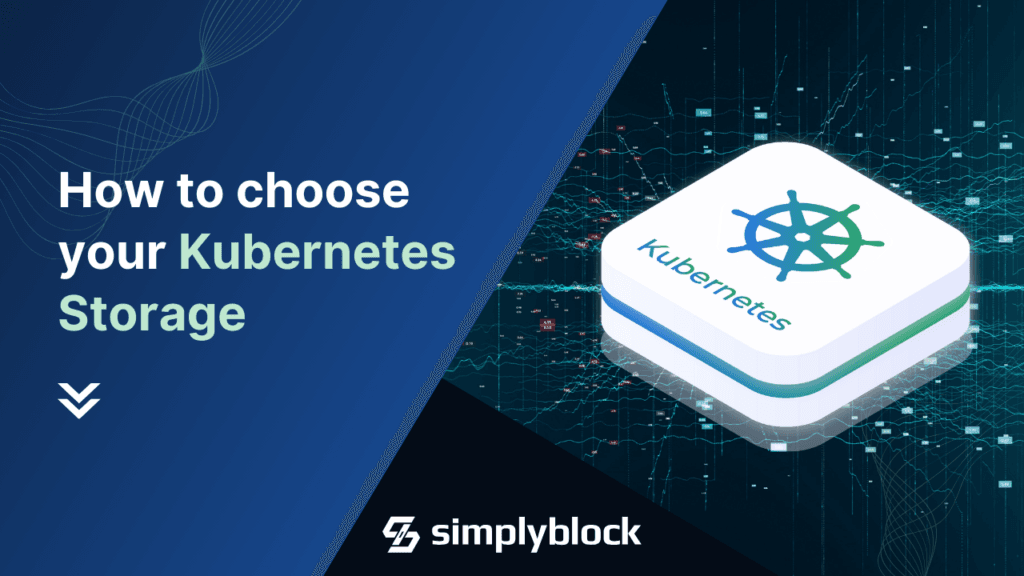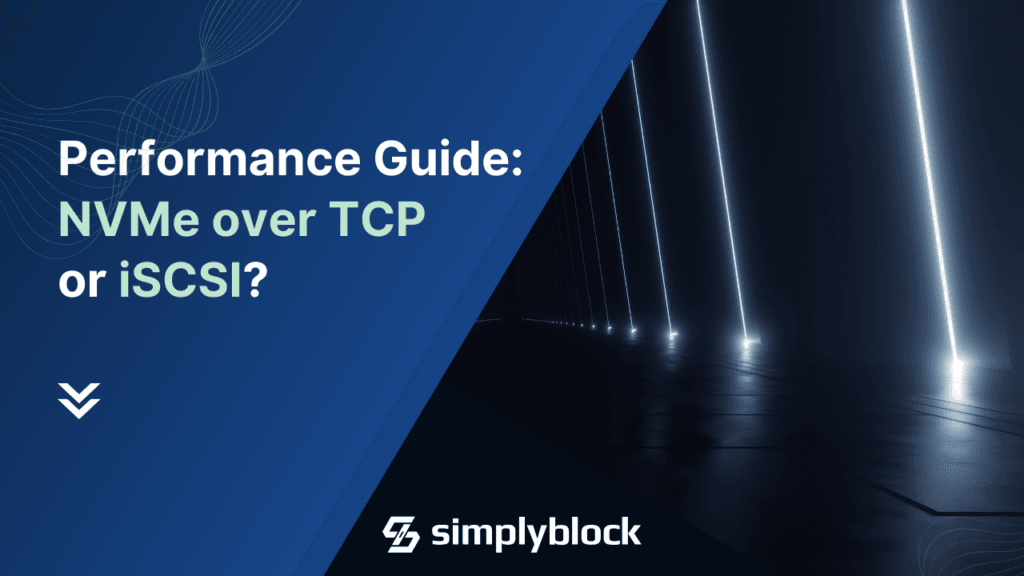
StorPool is a software-defined storage (SDS) solution designed for high-performance, scalable block storage, primarily targeting cloud service providers and enterprises. It offers features like advanced volume management, low latency, and great IOPS density. However, as storage needs evolve, several competitors provide alternatives that emphasize flexibility, cost-efficiency, and advanced features beyond what StorPool offers.
What Simplyblock Offers Beyond StorPool
Simplyblock delivers a cutting-edge software-defined storage platform tailored for high-performance workloads. Its modular, adaptive, unified, shared-everything (MAUS) architecture supports NVMe over Fabrics (NVMe-oF), Kubernetes-native deployments, and seamless scalability across diverse environments. Designed to meet the demands of modern enterprises, simplyblock offers a robust alternative to traditional SDS solutions like StorPool.
Benefits of Simplyblock
Benefits You Get with simplyblock
- Linear Scale-Out Performance: Expand storage capacity without compromising performance.
- Advanced Erasure Coding: Enhanced data protection with efficient storage utilization.
- High IOPS Density: Optimized for demanding workloads requiring rapid data access.
- Support for ARM64 and x64: Flexibility to deploy across various hardware platforms.
- DPU Optimization: Offload storage tasks to Data Processing Units for improved efficiency.
- End-to-End NVMe-oF Support: Ensure low-latency, high-throughput storage networking.
- Application-Transparent Storage Tiering: Automatically move data between storage tiers without application awareness.
Key Differences Between Simplyblock and StorPool
- Deployment Flexibility: Unlike StorPool’s focus on specific environments, simplyblock offers broader NVMe-oF support, accommodating diverse networking environments.
- Cost Efficiency: Reduce capital expenditures by leveraging existing hardware and avoiding vendor lock-in.
- Simplified Operations: Streamline management with Kubernetes-native integration and automated tiering.
- Future-Proof Architecture: Stay ahead with support for emerging technologies like DPUs and ARM64.
Storage Platforms Powering Scalable, Flexible Infrastructure
Modern workloads demand storage solutions that are scalable, cost-effective, and easy to manage. StorPool competitors like Ceph, StarWind, DataCore, and Red Hat Gluster offer unique approaches to meeting these needs.
This section highlights how each solution supports performance, availability, and infrastructure flexibility.
Ceph
Ceph is an open-source storage platform that provides object, block, and file storage in a unified system. It’s designed for scalability and high availability, making it suitable for large-scale deployments. Ceph’s self-healing and self-managing capabilities reduce administrative overhead.
StarWind Virtual SAN
StarWind Virtual SAN is a software-defined storage solution that eliminates the need for physical shared storage by mirroring internal hard disks and flash between hypervisor servers. It’s tailored for small and medium-sized businesses seeking cost-effective high availability.
DataCore
DataCore SANsymphony offers storage virtualization to optimize existing storage infrastructure. It provides high availability, performance acceleration, and centralized management, catering to enterprises aiming to maximize ROI on storage investments.
Red Hat Gluster
Red Hat Gluster Storage is an open-source, scalable, and highly available storage platform. It’s designed for cloud environments and handles large amounts of unstructured data, making it suitable for big data analytics and media streaming.
Technical Feature Breakdown Across Modern Storage Solutions
| Feature | simplyblock™ | StorPool | Ceph | StarWind | DataCore | Red Hat Gluster |
|---|---|---|---|---|---|---|
| Linear Scale-Out Performance | ✅ | ✅ | ✅ | ❌ | ✅ | ❌ |
| Advanced (Distributed) Erasure Coding | ✅ | ❌ | ❌ | ❌ | ❌ | ❌ |
| High IOPS Density | ✅ | ✅ | ❌ | ❌ | ❌ | ❌ |
| Supports ARM64 and x64 | ✅ | ✅ | ✅ | ❌ | ❌ | ❌ |
| DPU Optimized | ✅ | ❌ | ❌ | ❌ | ❌ | ❌ |
| End-to-End NVMe-oF Support | ✅ | ❌ | ❌ | ❌ | ❌ | ❌ |
| Application-Transparent Storage Tiering | ✅ | ❌ | ❌ | ❌ | ❌ | ❌ |
Making the Right Storage Choice for Modern Demands
Selecting the optimal storage solution is crucial for meeting your organization’s performance, scalability, and cost objectives. While StorPool offers robust SDS platforms, alternatives like simplyblock provide enhanced performance, simplified management, and better integration with modern infrastructures.
Why Simplyblock Stands Out as a StorPool Competitor
Simplyblock combines the benefits of software-defined storage with cutting-edge technologies, ensuring your infrastructure is ready for current and future demands. Its emphasis on flexibility, efficiency, and integration positions it as a superior choice for organizations seeking to optimize their storage strategy.
Questions and Answers
StorPool offers high IOPS and low latency, but competitors using simplyblock’s NVMe over Fabrics (NVMe-oF) technology provide significantly lower latency and higher throughput. Simplyblock’s shared-everything architecture ensures seamless scalability, making it a strong contender for performance-driven environments. While StorPool is efficient, Simplyblock delivers superior performance for demanding workloads, especially with Kubernetes-native integration for containerized environments.
StorPool requires significant investment in proprietary hardware, whereas simplyblock provides a software-defined storage solution that runs on commodity hardware, offering better cost-efficiency. With Kubernetes-native integration, Simplyblock reduces the need for expensive hardware upgrades, offering scalable and flexible solutions at a lower cost compared to StorPool’s pricing model.
StorPool excels with high IOPS density and scalability, but simplyblock enhances performance through end-to-end NVMe-oF support, providing low-latency, high-throughput storage. Additionally, simplyblock’s advanced erasure coding ensures better data protection, which makes it a more reliable choice for modern workloads compared to traditional SDS platforms like StorPool.
StorPool’s pricing can be high due to its hardware-centric approach. In contrast, Simplyblock offers cost-efficient software-defined storage, allowing businesses to use existing infrastructure and avoid vendor lock-in. Simplyblock’s flexible pricing model and linear scale-out performance make it a more affordable option for businesses looking to optimize their storage costs compared to StorPool.
Competitors like Simplyblock optimize performance with DPU optimization, offloading tasks for better efficiency. Automated storage tiering helps Simplyblock reduce costs by intelligently managing data between storage tiers. In addition, Simplyblock’s end-to-end NVMe-oF support ensures high throughput with low latency, optimizing both performance and cost management effectively compared to StorPool.



